Migration | Resident Return Visa
VerifiedAdded on 2022/08/11
|10
|2434
|33
AI Summary
Contribute Materials
Your contribution can guide someone’s learning journey. Share your
documents today.
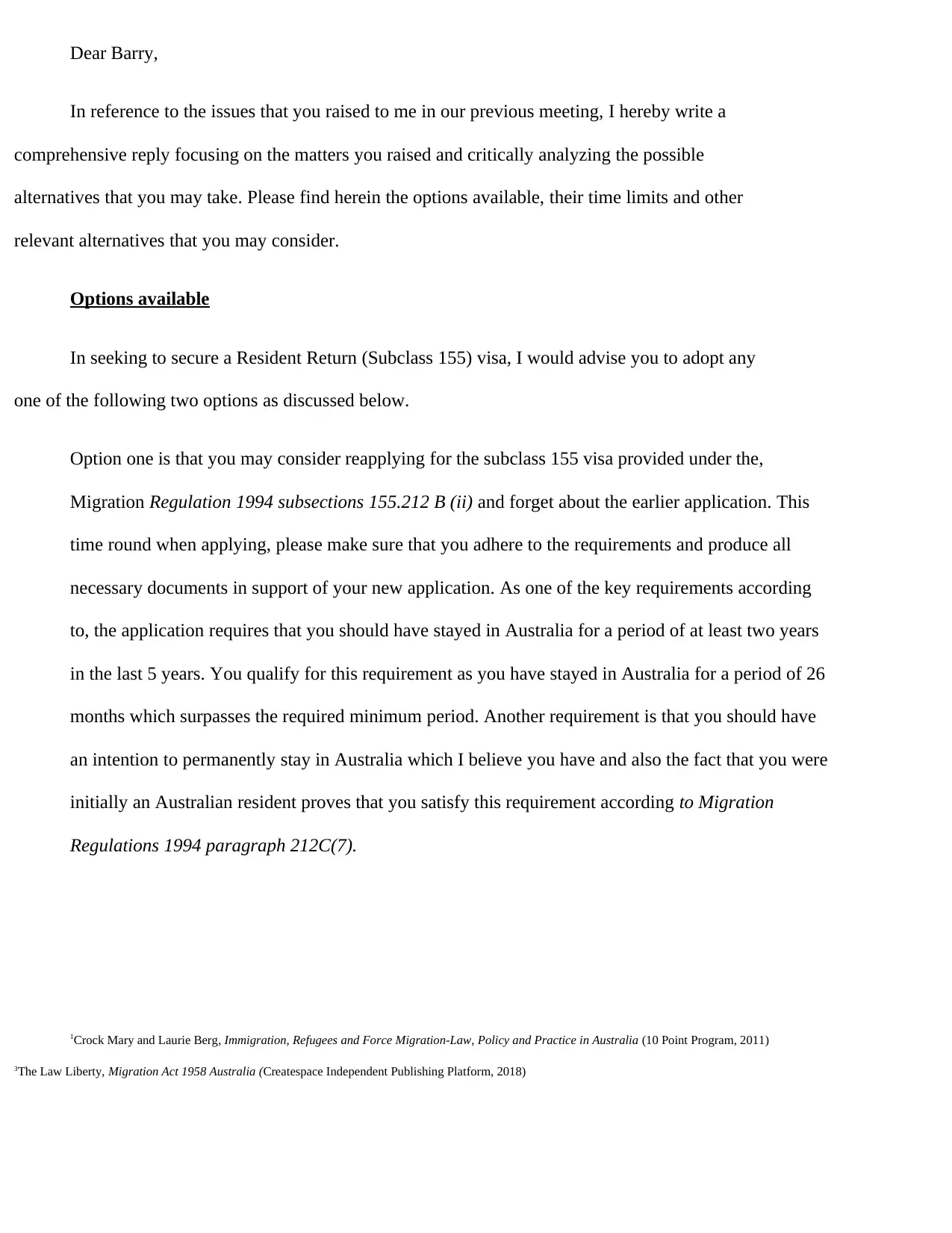
Dear Barry,
In reference to the issues that you raised to me in our previous meeting, I hereby write a
comprehensive reply focusing on the matters you raised and critically analyzing the possible
alternatives that you may take. Please find herein the options available, their time limits and other
relevant alternatives that you may consider.
Options available
In seeking to secure a Resident Return (Subclass 155) visa, I would advise you to adopt any
one of the following two options as discussed below.
Option one is that you may consider reapplying for the subclass 155 visa provided under the,
Migration Regulation 1994 subsections 155.212 B (ii) and forget about the earlier application. This
time round when applying, please make sure that you adhere to the requirements and produce all
necessary documents in support of your new application. As one of the key requirements according
to, the application requires that you should have stayed in Australia for a period of at least two years
in the last 5 years. You qualify for this requirement as you have stayed in Australia for a period of 26
months which surpasses the required minimum period. Another requirement is that you should have
an intention to permanently stay in Australia which I believe you have and also the fact that you were
initially an Australian resident proves that you satisfy this requirement according to Migration
Regulations 1994 paragraph 212C(7).
1Crock Mary and Laurie Berg, Immigration, Refugees and Force Migration-Law, Policy and Practice in Australia (10 Point Program, 2011)
3The Law Liberty, Migration Act 1958 Australia (Createspace Independent Publishing Platform, 2018)
In reference to the issues that you raised to me in our previous meeting, I hereby write a
comprehensive reply focusing on the matters you raised and critically analyzing the possible
alternatives that you may take. Please find herein the options available, their time limits and other
relevant alternatives that you may consider.
Options available
In seeking to secure a Resident Return (Subclass 155) visa, I would advise you to adopt any
one of the following two options as discussed below.
Option one is that you may consider reapplying for the subclass 155 visa provided under the,
Migration Regulation 1994 subsections 155.212 B (ii) and forget about the earlier application. This
time round when applying, please make sure that you adhere to the requirements and produce all
necessary documents in support of your new application. As one of the key requirements according
to, the application requires that you should have stayed in Australia for a period of at least two years
in the last 5 years. You qualify for this requirement as you have stayed in Australia for a period of 26
months which surpasses the required minimum period. Another requirement is that you should have
an intention to permanently stay in Australia which I believe you have and also the fact that you were
initially an Australian resident proves that you satisfy this requirement according to Migration
Regulations 1994 paragraph 212C(7).
1Crock Mary and Laurie Berg, Immigration, Refugees and Force Migration-Law, Policy and Practice in Australia (10 Point Program, 2011)
3The Law Liberty, Migration Act 1958 Australia (Createspace Independent Publishing Platform, 2018)
Secure Best Marks with AI Grader
Need help grading? Try our AI Grader for instant feedback on your assignments.
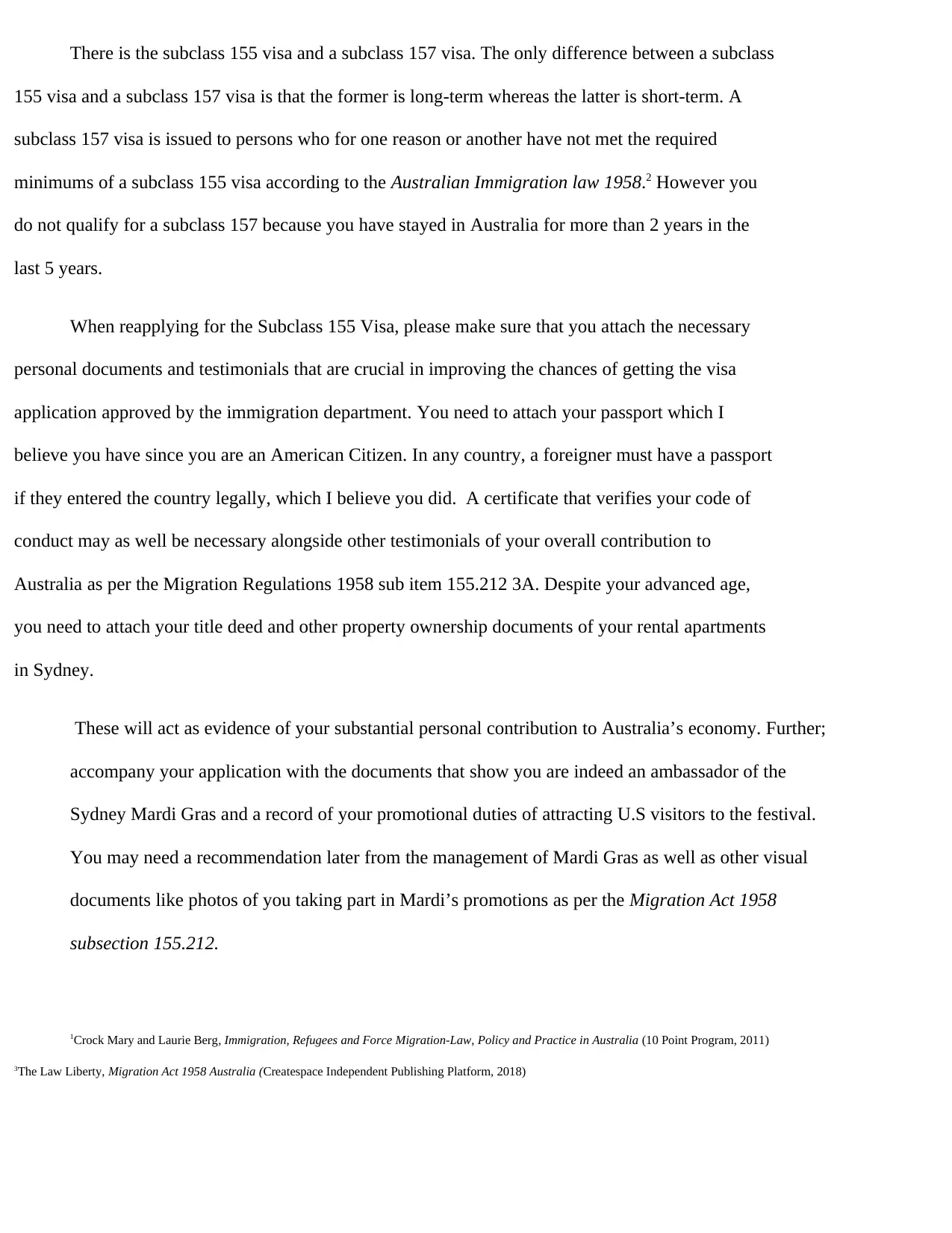
There is the subclass 155 visa and a subclass 157 visa. The only difference between a subclass
155 visa and a subclass 157 visa is that the former is long-term whereas the latter is short-term. A
subclass 157 visa is issued to persons who for one reason or another have not met the required
minimums of a subclass 155 visa according to the Australian Immigration law 1958.2 However you
do not qualify for a subclass 157 because you have stayed in Australia for more than 2 years in the
last 5 years.
When reapplying for the Subclass 155 Visa, please make sure that you attach the necessary
personal documents and testimonials that are crucial in improving the chances of getting the visa
application approved by the immigration department. You need to attach your passport which I
believe you have since you are an American Citizen. In any country, a foreigner must have a passport
if they entered the country legally, which I believe you did. A certificate that verifies your code of
conduct may as well be necessary alongside other testimonials of your overall contribution to
Australia as per the Migration Regulations 1958 sub item 155.212 3A. Despite your advanced age,
you need to attach your title deed and other property ownership documents of your rental apartments
in Sydney.
These will act as evidence of your substantial personal contribution to Australia’s economy. Further;
accompany your application with the documents that show you are indeed an ambassador of the
Sydney Mardi Gras and a record of your promotional duties of attracting U.S visitors to the festival.
You may need a recommendation later from the management of Mardi Gras as well as other visual
documents like photos of you taking part in Mardi’s promotions as per the Migration Act 1958
subsection 155.212.
1Crock Mary and Laurie Berg, Immigration, Refugees and Force Migration-Law, Policy and Practice in Australia (10 Point Program, 2011)
3The Law Liberty, Migration Act 1958 Australia (Createspace Independent Publishing Platform, 2018)
155 visa and a subclass 157 visa is that the former is long-term whereas the latter is short-term. A
subclass 157 visa is issued to persons who for one reason or another have not met the required
minimums of a subclass 155 visa according to the Australian Immigration law 1958.2 However you
do not qualify for a subclass 157 because you have stayed in Australia for more than 2 years in the
last 5 years.
When reapplying for the Subclass 155 Visa, please make sure that you attach the necessary
personal documents and testimonials that are crucial in improving the chances of getting the visa
application approved by the immigration department. You need to attach your passport which I
believe you have since you are an American Citizen. In any country, a foreigner must have a passport
if they entered the country legally, which I believe you did. A certificate that verifies your code of
conduct may as well be necessary alongside other testimonials of your overall contribution to
Australia as per the Migration Regulations 1958 sub item 155.212 3A. Despite your advanced age,
you need to attach your title deed and other property ownership documents of your rental apartments
in Sydney.
These will act as evidence of your substantial personal contribution to Australia’s economy. Further;
accompany your application with the documents that show you are indeed an ambassador of the
Sydney Mardi Gras and a record of your promotional duties of attracting U.S visitors to the festival.
You may need a recommendation later from the management of Mardi Gras as well as other visual
documents like photos of you taking part in Mardi’s promotions as per the Migration Act 1958
subsection 155.212.
1Crock Mary and Laurie Berg, Immigration, Refugees and Force Migration-Law, Policy and Practice in Australia (10 Point Program, 2011)
3The Law Liberty, Migration Act 1958 Australia (Createspace Independent Publishing Platform, 2018)
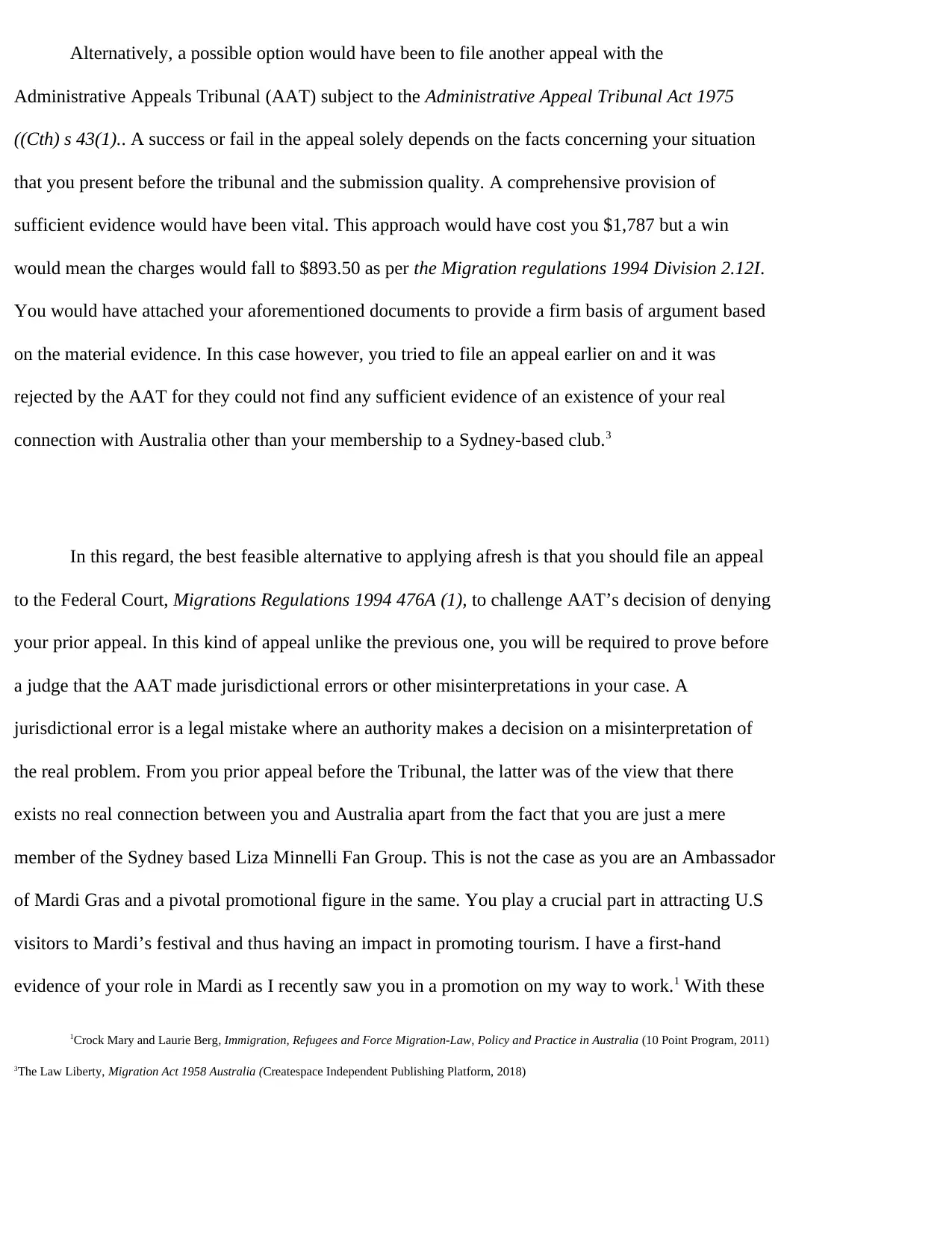
Alternatively, a possible option would have been to file another appeal with the
Administrative Appeals Tribunal (AAT) subject to the Administrative Appeal Tribunal Act 1975
((Cth) s 43(1).. A success or fail in the appeal solely depends on the facts concerning your situation
that you present before the tribunal and the submission quality. A comprehensive provision of
sufficient evidence would have been vital. This approach would have cost you $1,787 but a win
would mean the charges would fall to $893.50 as per the Migration regulations 1994 Division 2.12I.
You would have attached your aforementioned documents to provide a firm basis of argument based
on the material evidence. In this case however, you tried to file an appeal earlier on and it was
rejected by the AAT for they could not find any sufficient evidence of an existence of your real
connection with Australia other than your membership to a Sydney-based club.3
In this regard, the best feasible alternative to applying afresh is that you should file an appeal
to the Federal Court, Migrations Regulations 1994 476A (1), to challenge AAT’s decision of denying
your prior appeal. In this kind of appeal unlike the previous one, you will be required to prove before
a judge that the AAT made jurisdictional errors or other misinterpretations in your case. A
jurisdictional error is a legal mistake where an authority makes a decision on a misinterpretation of
the real problem. From you prior appeal before the Tribunal, the latter was of the view that there
exists no real connection between you and Australia apart from the fact that you are just a mere
member of the Sydney based Liza Minnelli Fan Group. This is not the case as you are an Ambassador
of Mardi Gras and a pivotal promotional figure in the same. You play a crucial part in attracting U.S
visitors to Mardi’s festival and thus having an impact in promoting tourism. I have a first-hand
evidence of your role in Mardi as I recently saw you in a promotion on my way to work.1 With these
1Crock Mary and Laurie Berg, Immigration, Refugees and Force Migration-Law, Policy and Practice in Australia (10 Point Program, 2011)
3The Law Liberty, Migration Act 1958 Australia (Createspace Independent Publishing Platform, 2018)
Administrative Appeals Tribunal (AAT) subject to the Administrative Appeal Tribunal Act 1975
((Cth) s 43(1).. A success or fail in the appeal solely depends on the facts concerning your situation
that you present before the tribunal and the submission quality. A comprehensive provision of
sufficient evidence would have been vital. This approach would have cost you $1,787 but a win
would mean the charges would fall to $893.50 as per the Migration regulations 1994 Division 2.12I.
You would have attached your aforementioned documents to provide a firm basis of argument based
on the material evidence. In this case however, you tried to file an appeal earlier on and it was
rejected by the AAT for they could not find any sufficient evidence of an existence of your real
connection with Australia other than your membership to a Sydney-based club.3
In this regard, the best feasible alternative to applying afresh is that you should file an appeal
to the Federal Court, Migrations Regulations 1994 476A (1), to challenge AAT’s decision of denying
your prior appeal. In this kind of appeal unlike the previous one, you will be required to prove before
a judge that the AAT made jurisdictional errors or other misinterpretations in your case. A
jurisdictional error is a legal mistake where an authority makes a decision on a misinterpretation of
the real problem. From you prior appeal before the Tribunal, the latter was of the view that there
exists no real connection between you and Australia apart from the fact that you are just a mere
member of the Sydney based Liza Minnelli Fan Group. This is not the case as you are an Ambassador
of Mardi Gras and a pivotal promotional figure in the same. You play a crucial part in attracting U.S
visitors to Mardi’s festival and thus having an impact in promoting tourism. I have a first-hand
evidence of your role in Mardi as I recently saw you in a promotion on my way to work.1 With these
1Crock Mary and Laurie Berg, Immigration, Refugees and Force Migration-Law, Policy and Practice in Australia (10 Point Program, 2011)
3The Law Liberty, Migration Act 1958 Australia (Createspace Independent Publishing Platform, 2018)
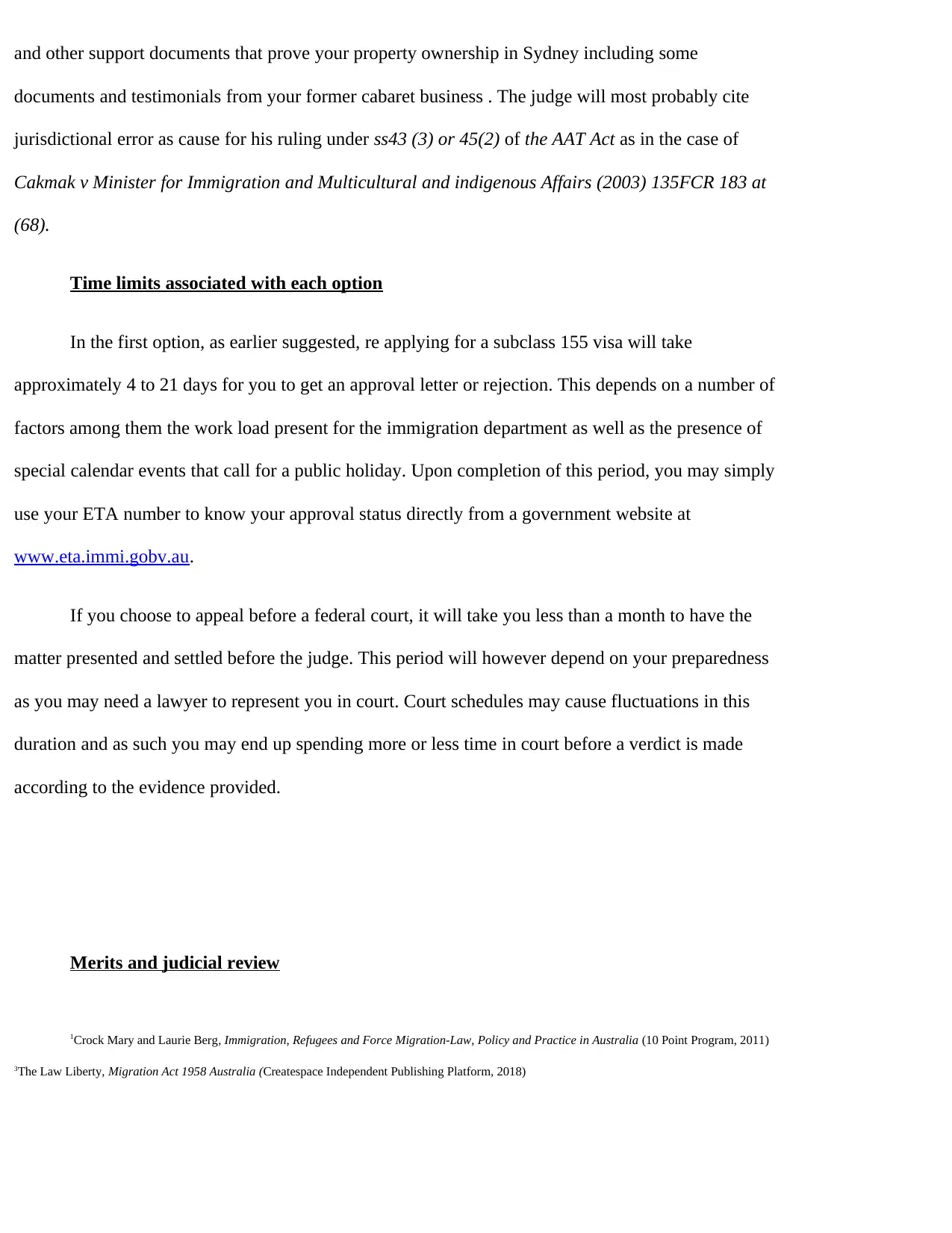
and other support documents that prove your property ownership in Sydney including some
documents and testimonials from your former cabaret business . The judge will most probably cite
jurisdictional error as cause for his ruling under ss43 (3) or 45(2) of the AAT Act as in the case of
Cakmak v Minister for Immigration and Multicultural and indigenous Affairs (2003) 135FCR 183 at
(68).
Time limits associated with each option
In the first option, as earlier suggested, re applying for a subclass 155 visa will take
approximately 4 to 21 days for you to get an approval letter or rejection. This depends on a number of
factors among them the work load present for the immigration department as well as the presence of
special calendar events that call for a public holiday. Upon completion of this period, you may simply
use your ETA number to know your approval status directly from a government website at
www.eta.immi.gobv.au.
If you choose to appeal before a federal court, it will take you less than a month to have the
matter presented and settled before the judge. This period will however depend on your preparedness
as you may need a lawyer to represent you in court. Court schedules may cause fluctuations in this
duration and as such you may end up spending more or less time in court before a verdict is made
according to the evidence provided.
Merits and judicial review
1Crock Mary and Laurie Berg, Immigration, Refugees and Force Migration-Law, Policy and Practice in Australia (10 Point Program, 2011)
3The Law Liberty, Migration Act 1958 Australia (Createspace Independent Publishing Platform, 2018)
documents and testimonials from your former cabaret business . The judge will most probably cite
jurisdictional error as cause for his ruling under ss43 (3) or 45(2) of the AAT Act as in the case of
Cakmak v Minister for Immigration and Multicultural and indigenous Affairs (2003) 135FCR 183 at
(68).
Time limits associated with each option
In the first option, as earlier suggested, re applying for a subclass 155 visa will take
approximately 4 to 21 days for you to get an approval letter or rejection. This depends on a number of
factors among them the work load present for the immigration department as well as the presence of
special calendar events that call for a public holiday. Upon completion of this period, you may simply
use your ETA number to know your approval status directly from a government website at
www.eta.immi.gobv.au.
If you choose to appeal before a federal court, it will take you less than a month to have the
matter presented and settled before the judge. This period will however depend on your preparedness
as you may need a lawyer to represent you in court. Court schedules may cause fluctuations in this
duration and as such you may end up spending more or less time in court before a verdict is made
according to the evidence provided.
Merits and judicial review
1Crock Mary and Laurie Berg, Immigration, Refugees and Force Migration-Law, Policy and Practice in Australia (10 Point Program, 2011)
3The Law Liberty, Migration Act 1958 Australia (Createspace Independent Publishing Platform, 2018)
Secure Best Marks with AI Grader
Need help grading? Try our AI Grader for instant feedback on your assignments.
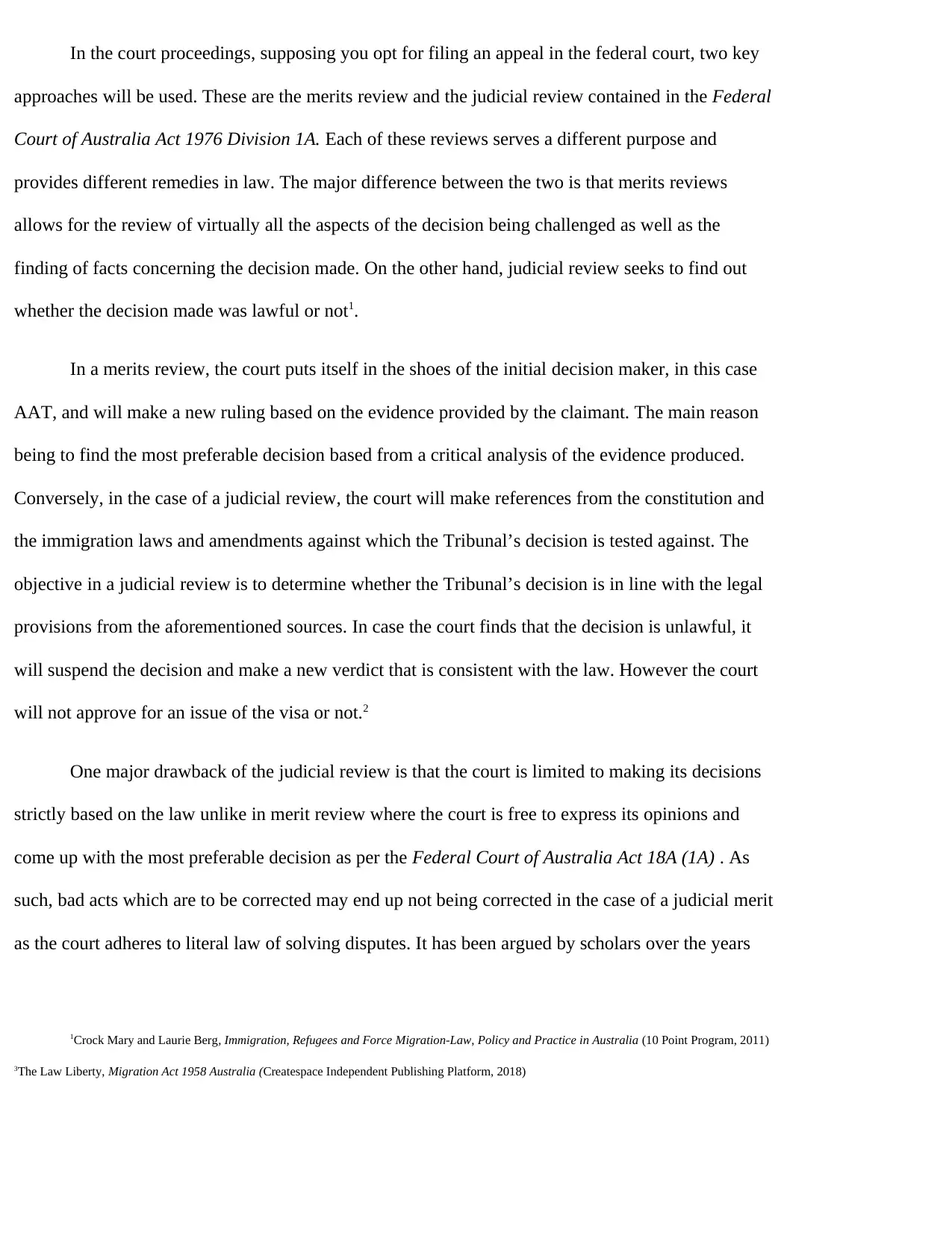
In the court proceedings, supposing you opt for filing an appeal in the federal court, two key
approaches will be used. These are the merits review and the judicial review contained in the Federal
Court of Australia Act 1976 Division 1A. Each of these reviews serves a different purpose and
provides different remedies in law. The major difference between the two is that merits reviews
allows for the review of virtually all the aspects of the decision being challenged as well as the
finding of facts concerning the decision made. On the other hand, judicial review seeks to find out
whether the decision made was lawful or not1.
In a merits review, the court puts itself in the shoes of the initial decision maker, in this case
AAT, and will make a new ruling based on the evidence provided by the claimant. The main reason
being to find the most preferable decision based from a critical analysis of the evidence produced.
Conversely, in the case of a judicial review, the court will make references from the constitution and
the immigration laws and amendments against which the Tribunal’s decision is tested against. The
objective in a judicial review is to determine whether the Tribunal’s decision is in line with the legal
provisions from the aforementioned sources. In case the court finds that the decision is unlawful, it
will suspend the decision and make a new verdict that is consistent with the law. However the court
will not approve for an issue of the visa or not.2
One major drawback of the judicial review is that the court is limited to making its decisions
strictly based on the law unlike in merit review where the court is free to express its opinions and
come up with the most preferable decision as per the Federal Court of Australia Act 18A (1A) . As
such, bad acts which are to be corrected may end up not being corrected in the case of a judicial merit
as the court adheres to literal law of solving disputes. It has been argued by scholars over the years
1Crock Mary and Laurie Berg, Immigration, Refugees and Force Migration-Law, Policy and Practice in Australia (10 Point Program, 2011)
3The Law Liberty, Migration Act 1958 Australia (Createspace Independent Publishing Platform, 2018)
approaches will be used. These are the merits review and the judicial review contained in the Federal
Court of Australia Act 1976 Division 1A. Each of these reviews serves a different purpose and
provides different remedies in law. The major difference between the two is that merits reviews
allows for the review of virtually all the aspects of the decision being challenged as well as the
finding of facts concerning the decision made. On the other hand, judicial review seeks to find out
whether the decision made was lawful or not1.
In a merits review, the court puts itself in the shoes of the initial decision maker, in this case
AAT, and will make a new ruling based on the evidence provided by the claimant. The main reason
being to find the most preferable decision based from a critical analysis of the evidence produced.
Conversely, in the case of a judicial review, the court will make references from the constitution and
the immigration laws and amendments against which the Tribunal’s decision is tested against. The
objective in a judicial review is to determine whether the Tribunal’s decision is in line with the legal
provisions from the aforementioned sources. In case the court finds that the decision is unlawful, it
will suspend the decision and make a new verdict that is consistent with the law. However the court
will not approve for an issue of the visa or not.2
One major drawback of the judicial review is that the court is limited to making its decisions
strictly based on the law unlike in merit review where the court is free to express its opinions and
come up with the most preferable decision as per the Federal Court of Australia Act 18A (1A) . As
such, bad acts which are to be corrected may end up not being corrected in the case of a judicial merit
as the court adheres to literal law of solving disputes. It has been argued by scholars over the years
1Crock Mary and Laurie Berg, Immigration, Refugees and Force Migration-Law, Policy and Practice in Australia (10 Point Program, 2011)
3The Law Liberty, Migration Act 1958 Australia (Createspace Independent Publishing Platform, 2018)
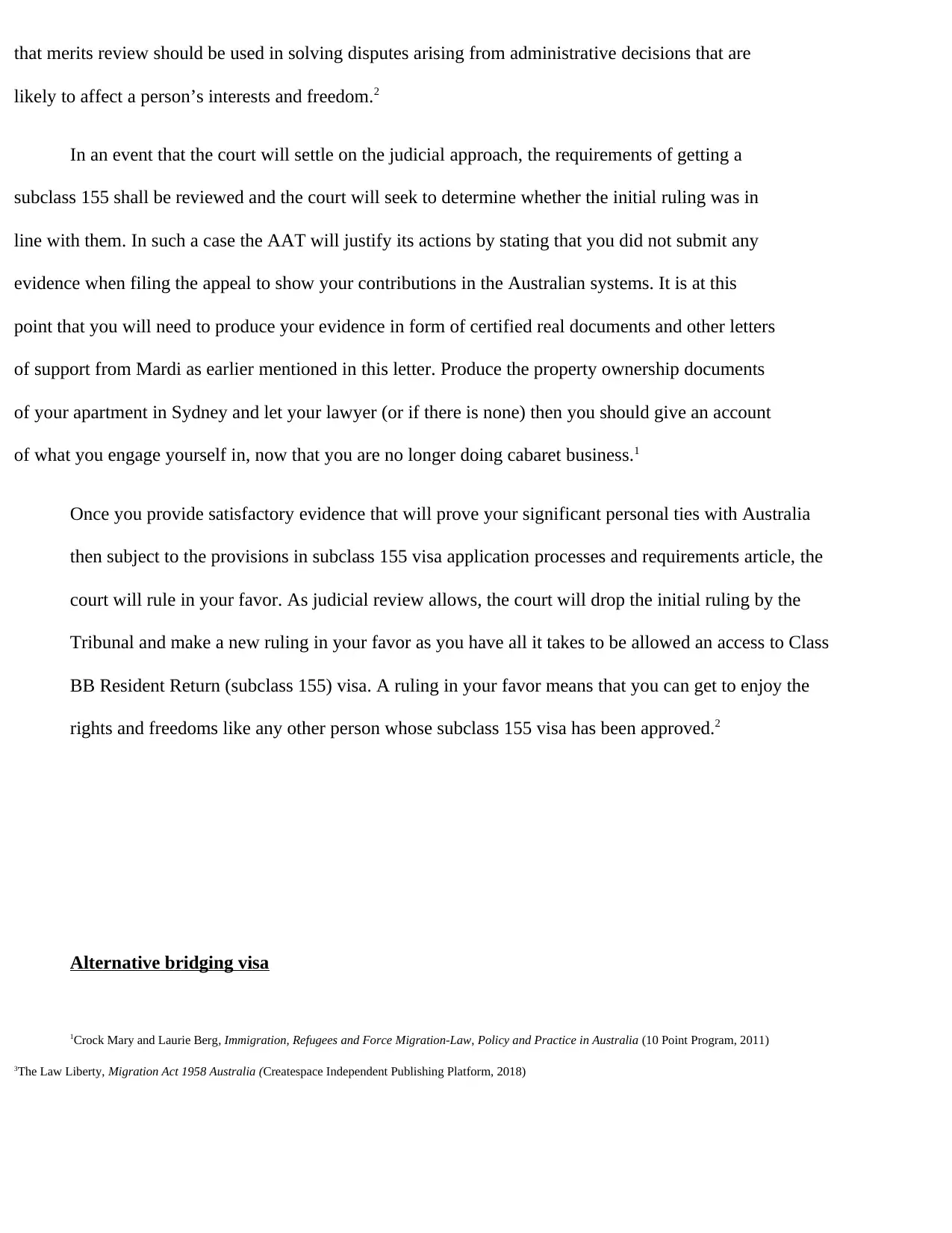
that merits review should be used in solving disputes arising from administrative decisions that are
likely to affect a person’s interests and freedom.2
In an event that the court will settle on the judicial approach, the requirements of getting a
subclass 155 shall be reviewed and the court will seek to determine whether the initial ruling was in
line with them. In such a case the AAT will justify its actions by stating that you did not submit any
evidence when filing the appeal to show your contributions in the Australian systems. It is at this
point that you will need to produce your evidence in form of certified real documents and other letters
of support from Mardi as earlier mentioned in this letter. Produce the property ownership documents
of your apartment in Sydney and let your lawyer (or if there is none) then you should give an account
of what you engage yourself in, now that you are no longer doing cabaret business.1
Once you provide satisfactory evidence that will prove your significant personal ties with Australia
then subject to the provisions in subclass 155 visa application processes and requirements article, the
court will rule in your favor. As judicial review allows, the court will drop the initial ruling by the
Tribunal and make a new ruling in your favor as you have all it takes to be allowed an access to Class
BB Resident Return (subclass 155) visa. A ruling in your favor means that you can get to enjoy the
rights and freedoms like any other person whose subclass 155 visa has been approved.2
Alternative bridging visa
1Crock Mary and Laurie Berg, Immigration, Refugees and Force Migration-Law, Policy and Practice in Australia (10 Point Program, 2011)
3The Law Liberty, Migration Act 1958 Australia (Createspace Independent Publishing Platform, 2018)
likely to affect a person’s interests and freedom.2
In an event that the court will settle on the judicial approach, the requirements of getting a
subclass 155 shall be reviewed and the court will seek to determine whether the initial ruling was in
line with them. In such a case the AAT will justify its actions by stating that you did not submit any
evidence when filing the appeal to show your contributions in the Australian systems. It is at this
point that you will need to produce your evidence in form of certified real documents and other letters
of support from Mardi as earlier mentioned in this letter. Produce the property ownership documents
of your apartment in Sydney and let your lawyer (or if there is none) then you should give an account
of what you engage yourself in, now that you are no longer doing cabaret business.1
Once you provide satisfactory evidence that will prove your significant personal ties with Australia
then subject to the provisions in subclass 155 visa application processes and requirements article, the
court will rule in your favor. As judicial review allows, the court will drop the initial ruling by the
Tribunal and make a new ruling in your favor as you have all it takes to be allowed an access to Class
BB Resident Return (subclass 155) visa. A ruling in your favor means that you can get to enjoy the
rights and freedoms like any other person whose subclass 155 visa has been approved.2
Alternative bridging visa
1Crock Mary and Laurie Berg, Immigration, Refugees and Force Migration-Law, Policy and Practice in Australia (10 Point Program, 2011)
3The Law Liberty, Migration Act 1958 Australia (Createspace Independent Publishing Platform, 2018)
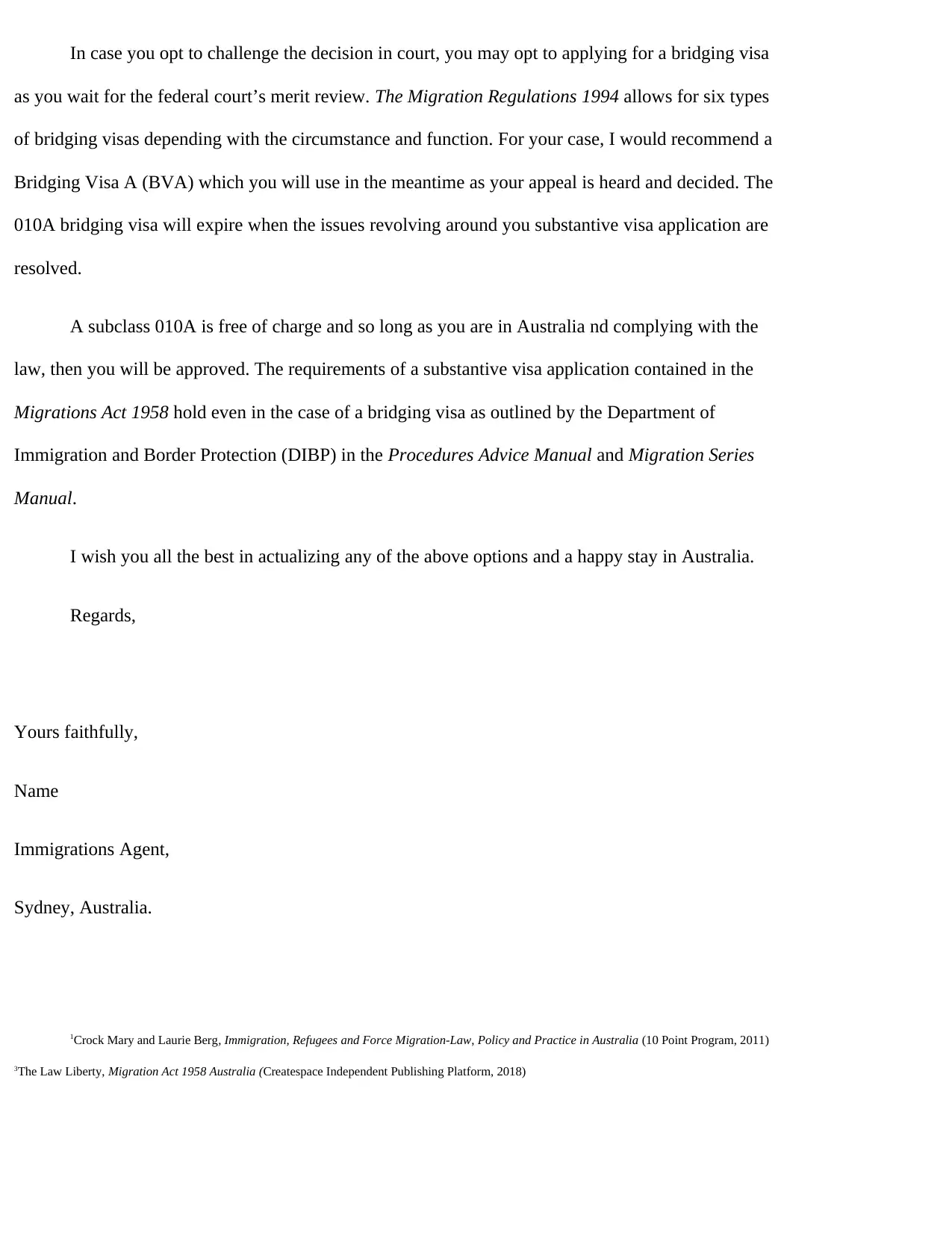
In case you opt to challenge the decision in court, you may opt to applying for a bridging visa
as you wait for the federal court’s merit review. The Migration Regulations 1994 allows for six types
of bridging visas depending with the circumstance and function. For your case, I would recommend a
Bridging Visa A (BVA) which you will use in the meantime as your appeal is heard and decided. The
010A bridging visa will expire when the issues revolving around you substantive visa application are
resolved.
A subclass 010A is free of charge and so long as you are in Australia nd complying with the
law, then you will be approved. The requirements of a substantive visa application contained in the
Migrations Act 1958 hold even in the case of a bridging visa as outlined by the Department of
Immigration and Border Protection (DIBP) in the Procedures Advice Manual and Migration Series
Manual.
I wish you all the best in actualizing any of the above options and a happy stay in Australia.
Regards,
Yours faithfully,
Name
Immigrations Agent,
Sydney, Australia.
1Crock Mary and Laurie Berg, Immigration, Refugees and Force Migration-Law, Policy and Practice in Australia (10 Point Program, 2011)
3The Law Liberty, Migration Act 1958 Australia (Createspace Independent Publishing Platform, 2018)
as you wait for the federal court’s merit review. The Migration Regulations 1994 allows for six types
of bridging visas depending with the circumstance and function. For your case, I would recommend a
Bridging Visa A (BVA) which you will use in the meantime as your appeal is heard and decided. The
010A bridging visa will expire when the issues revolving around you substantive visa application are
resolved.
A subclass 010A is free of charge and so long as you are in Australia nd complying with the
law, then you will be approved. The requirements of a substantive visa application contained in the
Migrations Act 1958 hold even in the case of a bridging visa as outlined by the Department of
Immigration and Border Protection (DIBP) in the Procedures Advice Manual and Migration Series
Manual.
I wish you all the best in actualizing any of the above options and a happy stay in Australia.
Regards,
Yours faithfully,
Name
Immigrations Agent,
Sydney, Australia.
1Crock Mary and Laurie Berg, Immigration, Refugees and Force Migration-Law, Policy and Practice in Australia (10 Point Program, 2011)
3The Law Liberty, Migration Act 1958 Australia (Createspace Independent Publishing Platform, 2018)
Paraphrase This Document
Need a fresh take? Get an instant paraphrase of this document with our AI Paraphraser
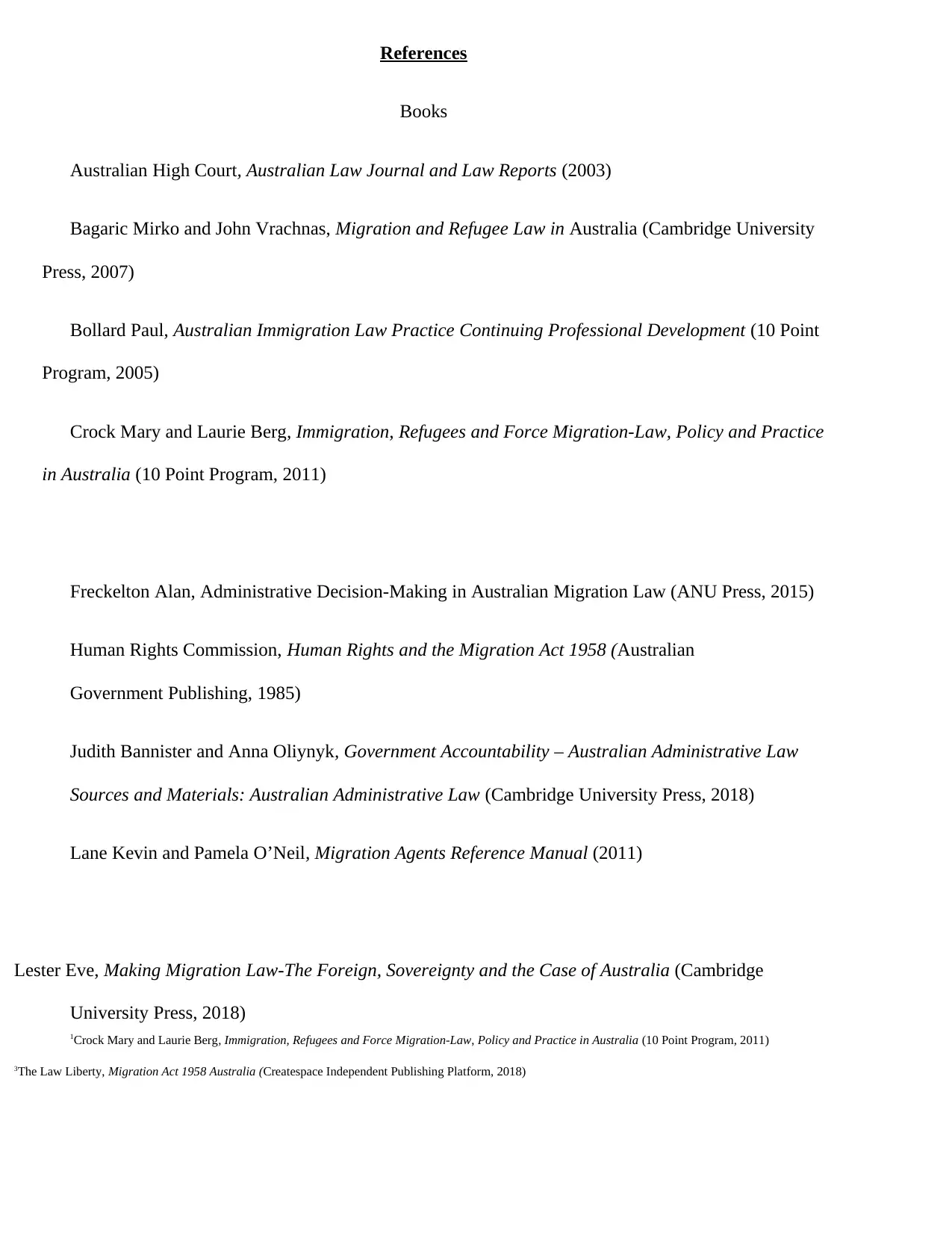
References
Books
Australian High Court, Australian Law Journal and Law Reports (2003)
Bagaric Mirko and John Vrachnas, Migration and Refugee Law in Australia (Cambridge University
Press, 2007)
Bollard Paul, Australian Immigration Law Practice Continuing Professional Development (10 Point
Program, 2005)
Crock Mary and Laurie Berg, Immigration, Refugees and Force Migration-Law, Policy and Practice
in Australia (10 Point Program, 2011)
Freckelton Alan, Administrative Decision-Making in Australian Migration Law (ANU Press, 2015)
Human Rights Commission, Human Rights and the Migration Act 1958 (Australian
Government Publishing, 1985)
Judith Bannister and Anna Oliynyk, Government Accountability – Australian Administrative Law
Sources and Materials: Australian Administrative Law (Cambridge University Press, 2018)
Lane Kevin and Pamela O’Neil, Migration Agents Reference Manual (2011)
Lester Eve, Making Migration Law-The Foreign, Sovereignty and the Case of Australia (Cambridge
University Press, 2018)
1Crock Mary and Laurie Berg, Immigration, Refugees and Force Migration-Law, Policy and Practice in Australia (10 Point Program, 2011)
3The Law Liberty, Migration Act 1958 Australia (Createspace Independent Publishing Platform, 2018)
Books
Australian High Court, Australian Law Journal and Law Reports (2003)
Bagaric Mirko and John Vrachnas, Migration and Refugee Law in Australia (Cambridge University
Press, 2007)
Bollard Paul, Australian Immigration Law Practice Continuing Professional Development (10 Point
Program, 2005)
Crock Mary and Laurie Berg, Immigration, Refugees and Force Migration-Law, Policy and Practice
in Australia (10 Point Program, 2011)
Freckelton Alan, Administrative Decision-Making in Australian Migration Law (ANU Press, 2015)
Human Rights Commission, Human Rights and the Migration Act 1958 (Australian
Government Publishing, 1985)
Judith Bannister and Anna Oliynyk, Government Accountability – Australian Administrative Law
Sources and Materials: Australian Administrative Law (Cambridge University Press, 2018)
Lane Kevin and Pamela O’Neil, Migration Agents Reference Manual (2011)
Lester Eve, Making Migration Law-The Foreign, Sovereignty and the Case of Australia (Cambridge
University Press, 2018)
1Crock Mary and Laurie Berg, Immigration, Refugees and Force Migration-Law, Policy and Practice in Australia (10 Point Program, 2011)
3The Law Liberty, Migration Act 1958 Australia (Createspace Independent Publishing Platform, 2018)
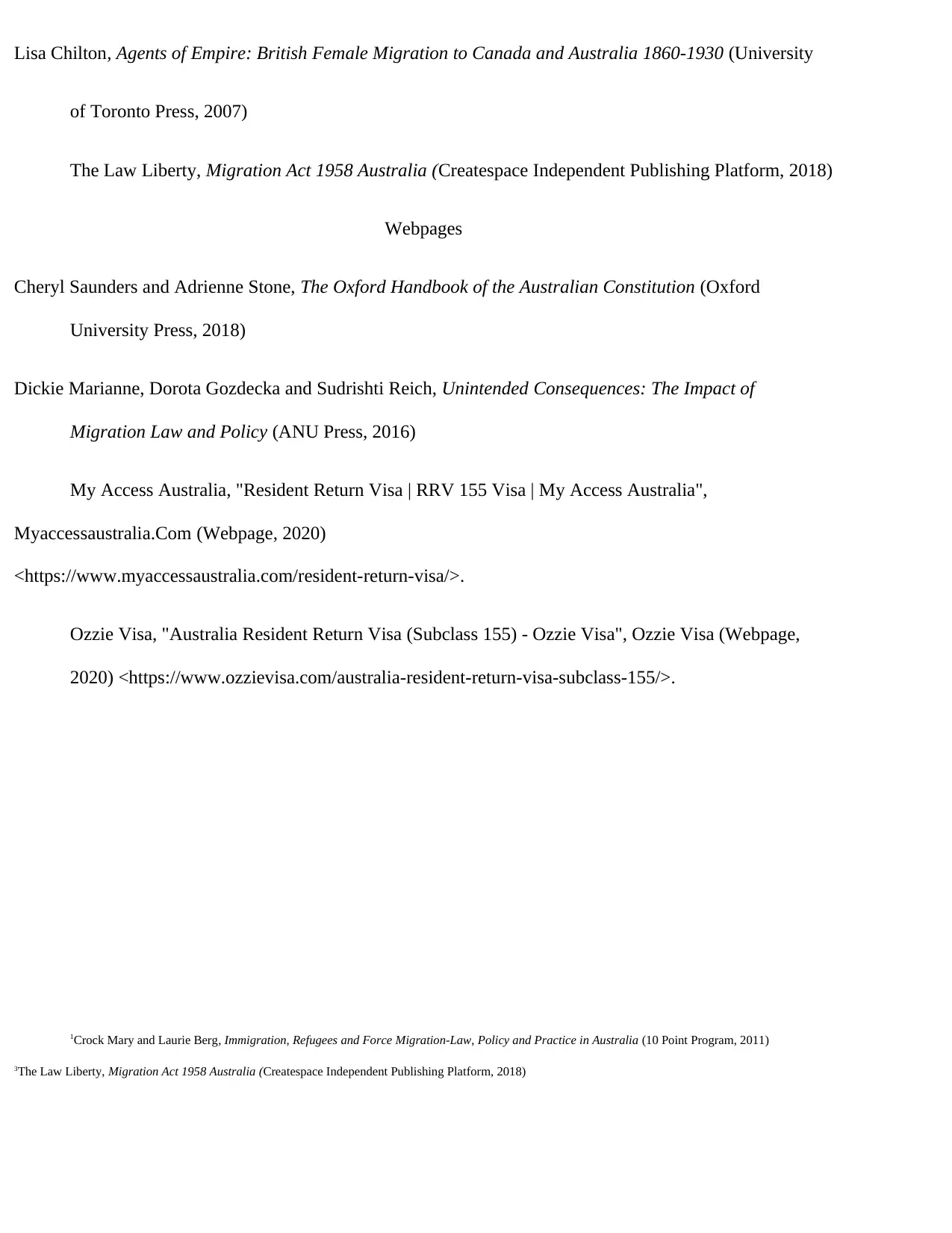
Lisa Chilton, Agents of Empire: British Female Migration to Canada and Australia 1860-1930 (University
of Toronto Press, 2007)
The Law Liberty, Migration Act 1958 Australia (Createspace Independent Publishing Platform, 2018)
Webpages
Cheryl Saunders and Adrienne Stone, The Oxford Handbook of the Australian Constitution (Oxford
University Press, 2018)
Dickie Marianne, Dorota Gozdecka and Sudrishti Reich, Unintended Consequences: The Impact of
Migration Law and Policy (ANU Press, 2016)
My Access Australia, "Resident Return Visa | RRV 155 Visa | My Access Australia",
Myaccessaustralia.Com (Webpage, 2020)
<https://www.myaccessaustralia.com/resident-return-visa/>.
Ozzie Visa, "Australia Resident Return Visa (Subclass 155) - Ozzie Visa", Ozzie Visa (Webpage,
2020) <https://www.ozzievisa.com/australia-resident-return-visa-subclass-155/>.
1Crock Mary and Laurie Berg, Immigration, Refugees and Force Migration-Law, Policy and Practice in Australia (10 Point Program, 2011)
3The Law Liberty, Migration Act 1958 Australia (Createspace Independent Publishing Platform, 2018)
of Toronto Press, 2007)
The Law Liberty, Migration Act 1958 Australia (Createspace Independent Publishing Platform, 2018)
Webpages
Cheryl Saunders and Adrienne Stone, The Oxford Handbook of the Australian Constitution (Oxford
University Press, 2018)
Dickie Marianne, Dorota Gozdecka and Sudrishti Reich, Unintended Consequences: The Impact of
Migration Law and Policy (ANU Press, 2016)
My Access Australia, "Resident Return Visa | RRV 155 Visa | My Access Australia",
Myaccessaustralia.Com (Webpage, 2020)
<https://www.myaccessaustralia.com/resident-return-visa/>.
Ozzie Visa, "Australia Resident Return Visa (Subclass 155) - Ozzie Visa", Ozzie Visa (Webpage,
2020) <https://www.ozzievisa.com/australia-resident-return-visa-subclass-155/>.
1Crock Mary and Laurie Berg, Immigration, Refugees and Force Migration-Law, Policy and Practice in Australia (10 Point Program, 2011)
3The Law Liberty, Migration Act 1958 Australia (Createspace Independent Publishing Platform, 2018)

1 out of 10
Related Documents
Your All-in-One AI-Powered Toolkit for Academic Success.
+13062052269
info@desklib.com
Available 24*7 on WhatsApp / Email
![[object Object]](/_next/static/media/star-bottom.7253800d.svg)
Unlock your academic potential
© 2024 | Zucol Services PVT LTD | All rights reserved.





